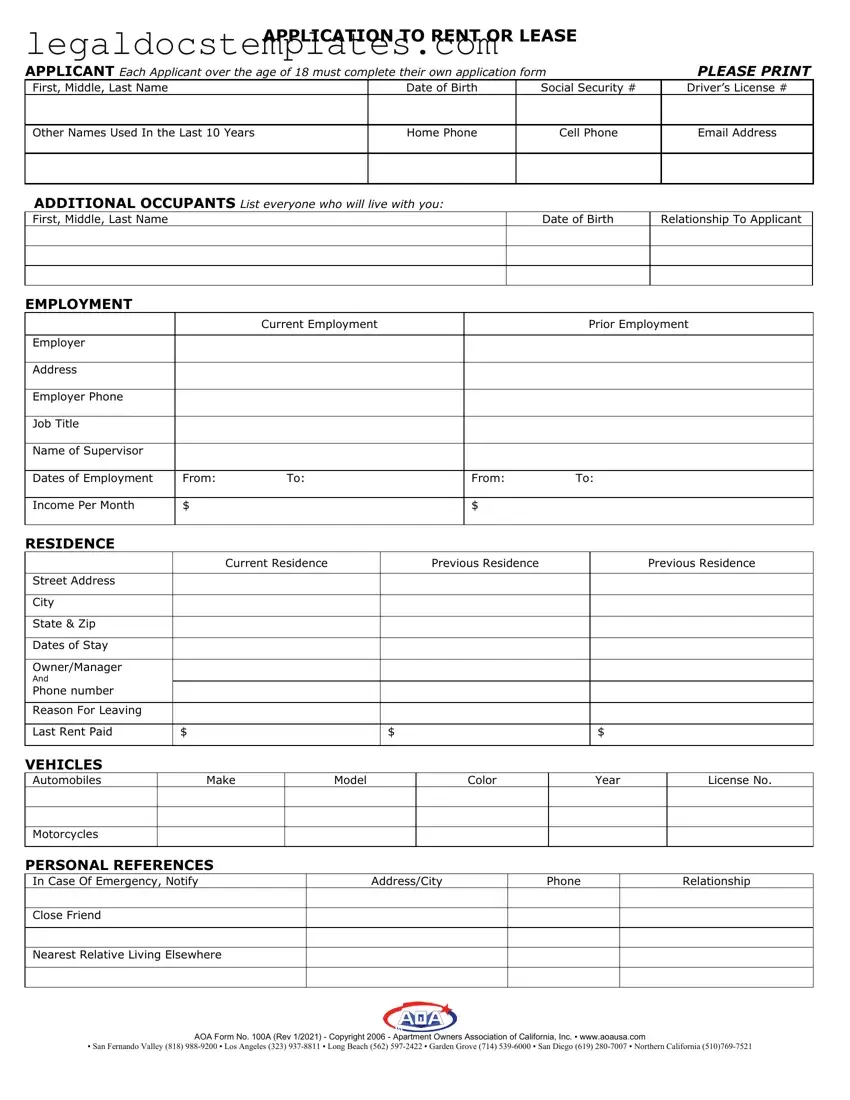APPLICATION TO RENT OR LEASE
APPLICANT Each Applicant over the age of 18 must complete their own application form |
PLEASE PRINT |
First, Middle, Last Name |
Date of Birth |
Social Security # |
Driver’s License # |
|
|
|
|
|
|
Other Names Used In the Last 10 Years |
Home Phone |
Cell Phone |
Email Address |
|
|
|
|
|
|
|
|
|
|
|
|
ADDITIONAL OCCUPANTS List everyone who will live with you: |
|
|
|
First, Middle, Last Name |
|
|
Date of Birth |
|
Relationship To Applicant |
|
|
|
|
|
|
|
|
|
|
|
|
|
|
|
|
|
|
EMPLOYMENT
|
|
Current Employment |
|
Prior Employment |
|
|
|
|
|
Employer |
|
|
|
|
|
|
|
|
|
Address |
|
|
|
|
|
|
|
|
|
Employer Phone |
|
|
|
|
|
|
|
|
|
Job Title |
|
|
|
|
|
|
|
|
|
Name of Supervisor |
|
|
|
|
|
|
|
|
|
Dates of Employment |
From: |
To: |
From: |
To: |
|
|
|
|
|
Income Per Month |
$ |
|
$ |
|
|
|
|
|
|
RESIDENCE
|
Current Residence |
Previous Residence |
Previous Residence |
|
|
|
|
Street Address |
|
|
|
|
|
|
|
City |
|
|
|
|
|
|
|
State & Zip |
|
|
|
|
|
|
|
Dates of Stay |
|
|
|
|
|
|
|
Owner/Manager |
|
|
|
And |
|
|
|
Phone number |
|
|
|
|
|
|
|
Reason For Leaving |
|
|
|
|
|
|
|
Last Rent Paid |
$ |
$ |
$ |
|
|
|
|
VEHICLES
Motorcycles
PERSONAL REFERENCES
In Case Of Emergency, Notify
Close Friend
Nearest Relative Living Elsewhere
AOA Form No. 100A (Rev 1/2021) - Copyright 2006 - Apartment Owners Association of California, Inc. ▪ www.aoausa.com
▪ San Fernando Valley (818) 988-9200 ▪ Los Angeles (323) 937-8811 ▪ Long Beach (562) 597-2422 ▪ Garden Grove (714) 539-6000 ▪ San Diego (619) 280-7007 ▪ Northern California (510)769-7521
CREDIT INFORMATION Please list all your financial obligations
Name of Bank or Savings & Loan |
|
Branch or Address |
|
Account No. |
Balance |
|
|
|
|
Checking |
|
|
$ |
|
|
|
|
|
|
|
|
|
|
|
|
Savings |
|
|
$ |
|
|
|
|
|
|
|
|
Credit Accounts |
Account No. |
|
Address/City |
Phone |
|
Balance |
Due Monthly |
|
|
|
|
|
|
|
|
|
|
|
|
|
|
|
|
|
|
|
|
|
|
|
|
|
|
|
|
|
|
|
|
|
|
|
|
|
|
|
|
GENERAL INFORMATION Check answer that applies |
|
|
|
|
Do you smoke? |
|
YES |
|
NO |
Do you have any pets/animals? |
|
YES |
|
NO |
Have you ever filed for bankruptcy? |
|
YES |
|
NO |
Do you have any musical instruments? |
|
YES |
|
NO |
Do you have any water-filled furniture or do you intend to use |
|
YES |
|
NO |
water filled furniture in the apartment? |
|
|
|
|
Have you ever been convicted for selling, possessing, |
|
YES |
|
NO |
distributing or manufacturing illegal drugs or convicted of any |
|
|
|
|
other crime? |
|
|
|
|
Have you ever been evicted or named as a defendant in an |
|
YES |
|
NO |
eviction for non-payment of rent or any other reason? |
|
|
|
|
Please explain any “yes” answers to the above questions:
________________________________________________________________________________________
________________________________________________________________________________________
________________________________________________________________________________________
Why are you leaving your current residence? ___________________________________________________
________________________________________________________________________________________
The applicant hereby applies to rent/lease Apartment #_________at___________________________
________________________________for $__________ per month, and upon owner’s approval agrees to
enter into a Rental Agreement and/or Lease and pay all rent and security deposits required before occupancy.
An application fee of $__________ is hereby submitted for the cost of processing this application, to obtain
credit history and other background information.
Applicant represents that all information given on this application is true and correct. Applicant hereby authorizes verification of all references and facts, including but not limited to current and previous landlords and employers, and personal references. Applicant hereby authorizes owner/agent to obtain Unlawful Detainer, Credit Reports, Telechecks, and/or criminal background reports. Applicant agrees to furnish additional credit and/or personal references upon request. Applicant understands that incomplete or incorrect information provided in the application may cause a delay in processing which may result in denial of tenancy. In the event that a material misstatement or misrepresentation is discovered after Applicant is accepted as a Resident, and whether or not a Lease or Month to Month Rental Agreement is executed, Owner may, at Owner’s sole discretion, deem such misstatement or misrepresentation to be a material and non-curable breach of any subsequent Lease or Month to Month Rental Agreement and grounds for rescission of the contract and immediate eviction. Applicant hereby waives any claim and releases from liability any person providing or obtaining said verification or additional information.
Applicant: _______________________________________Date: ___________________________
(Signature required)
AOA Form No. 100A (Rev 1/2021) - Copyright 2006 - Apartment Owners Association of California, Inc. ▪ www.aoausa.com
▪ San Fernando Valley (818) 988-9200 ▪ Los Angeles (323) 937-8811 ▪ Long Beach (562) 597-2422 ▪ Garden Grove (714) 539-6000 ▪ San Diego (619) 280-7007 ▪ Northern California (510)769-7521


